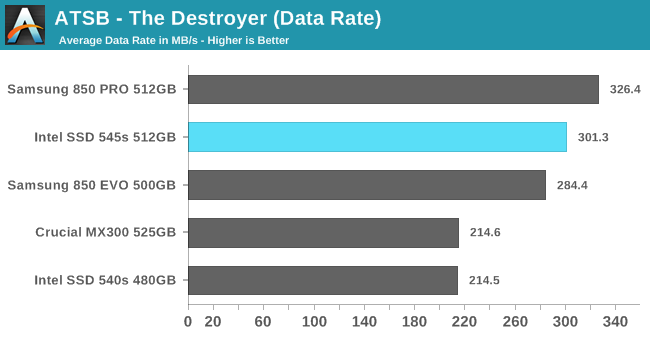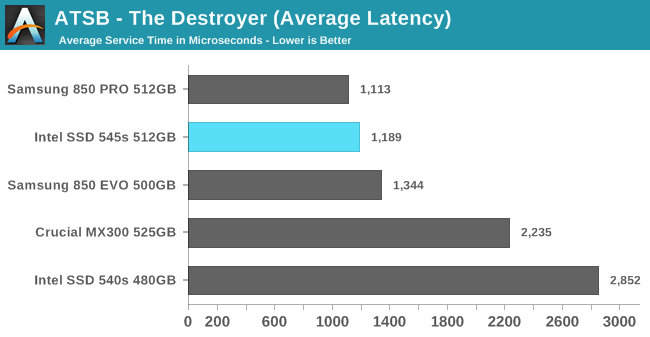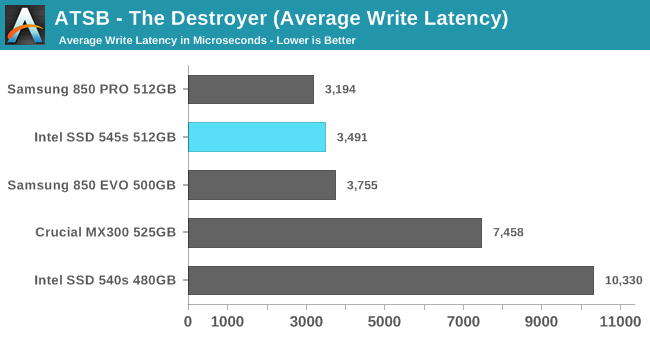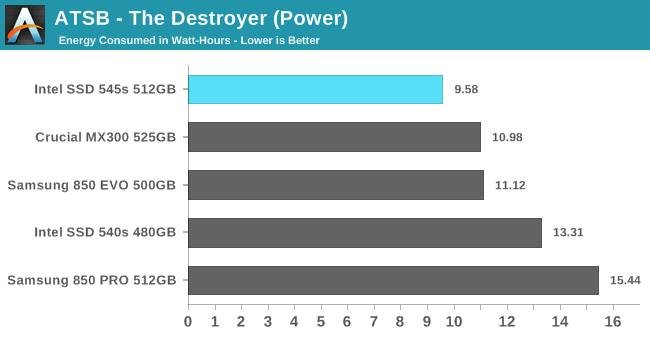The Intel SSD 545s (512GB) Review: 64-Layer 3D TLC NAND Hits Retail
by Billy Tallis on June 27, 2017 6:00 AM ESTAnandTech Storage Bench - The Destroyer
The Destroyer is an extremely long test replicating the access patterns of very IO-intensive desktop usage. A detailed breakdown can be found in this article. Like real-world usage, the drives do get the occasional break that allows for some background garbage collection and flushing caches, but those idle times are limited to 25ms so that it doesn't take all week to run the test. These AnandTech Storage Bench (ATSB) tests do not involve running the actual applications that generated the workloads, so the scores are relatively insensitive to changes in CPU performance and RAM from our new testbed, but the jump to a newer version of Windows and the newer storage drivers can have an impact.
We quantify performance on this test by reporting the drive's average data throughput, the average latency of the I/O operations, and the total energy used by the drive over the course of the test.

The Intel SSD 545s performs surprisingly well on The Destroyer, with an average data rate that surpasses the Samsung 850 EVO and potentially makes the 545s the new fastest SATA SSD with 3D NAND. The 3D MLC-based Samsung 850 PRO is still out of reach, but the 545s is a big improvement over the 540s and the Crucial MX300.

The Intel 545s also ranks between the Samsung 850 PRO and 850 EVO in terms of average latency, with slightly more than half the latency of the Crucial MX300 and an even wider margin over the Intel 540s.


Separating the latency according to reads and writes, we see that the 545s is much closer to the Samsung 850 PRO than the 850 EVO for reads. The write latencies of the Samsung drives and the 545s are all much lower than the Crucial MX300 or Intel 540s.

In addition to delivering great performance for a SATA TLC SSD, the Intel 545s brings a huge improvement in power efficiency. The 545s uses 12% less energy than the Crucial MX300 or Samsung 850 EVO over the course of the test. Only a few SSDs have ever completed The Destroyer on such a small energy budget, and only one other TLC SSD has been this efficient.










74 Comments
View All Comments
Billy Tallis - Tuesday, June 27, 2017 - link
I expect it'll be M.2 2280 for all the same capacities, though the 2TB M.2 would probably have to be double-sided. If Intel does a shorter M.2 version it'll more likely be sold as the OEM or embedded model.Rictorhell - Tuesday, June 27, 2017 - link
Thank you for your reply. Yeah, I am looking for a shorter model with a higher capacity than what is currently available. You have given me some hope that something that suits my needs may be released.Glock24 - Tuesday, June 27, 2017 - link
Nice to finally see a competitor to the 850Evo. Hopefully it's not overly expensive.Over at Storagereviews they experienced lockups due to firmware:
"Unstable firmware that causes SSD and attached system to lock under certain repeatable conditions"
Was your experience similar?
Billy Tallis - Tuesday, June 27, 2017 - link
I haven't experienced any lock-ups from the 545s yet, but I would expect the synthetic tests to be more likely to trigger something like that.tigz1218 - Tuesday, June 27, 2017 - link
Can someone explain to me why they still make these? Isn't m2 the better solution with 3,000mbs read/write?I am a noob so please go easy, thanks!
A5 - Tuesday, June 27, 2017 - link
These are cheaper and there are still a ton of computers that don't have M.2 slots.Vast majority of the market doesn't really need something that totally saturates SATA.
tigz1218 - Tuesday, June 27, 2017 - link
Cool thank you. I figured it was due to something like that.I noticed that difference in price between m2 and SSD isn't as drastic as when SSDs first came out compared to disc drives. Wondering if that means we will see m2 get adopted at a faster rate.
Thanks again :)
Kwarkon - Friday, June 30, 2017 - link
Hi there, you mean NVME SSD that use usually x4 PCIe with m.2 form factor.Because in fact there are also m.2 SATA SSD that perform and cost the same as 2.5" SATA SSD.
fanofanand - Tuesday, June 27, 2017 - link
How is M.2 more expensive? It's less hardware, I would assume it's vastly cheaper. They just charge more because it's still "new", but I fail to see how adding the enclosure etc. reduces cost.Tadashi130 - Tuesday, June 27, 2017 - link
Finding a way to route all connections on a smaller PCB is much harder.